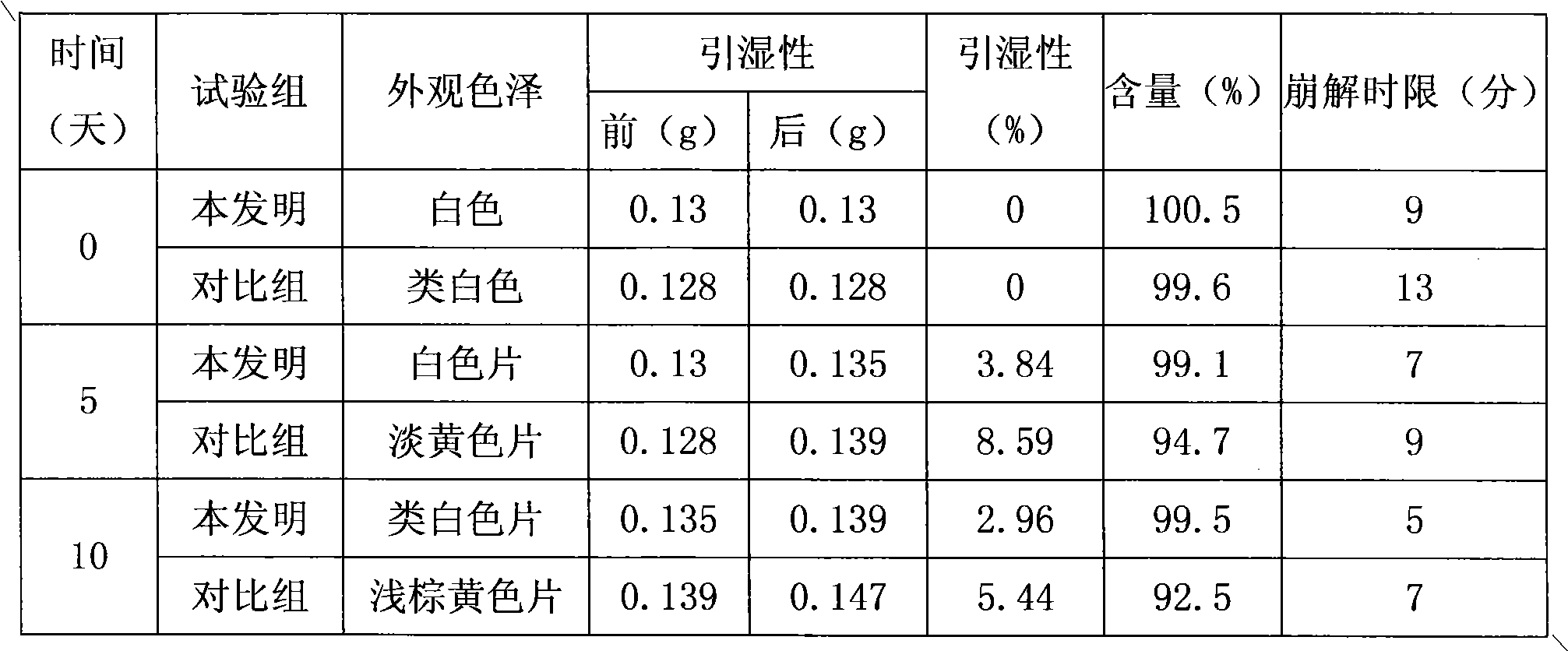Method for preparing vitamin C tablet
A vitamin and tablet technology, which is applied in the field of preparation of vitamin C tablets, can solve problems such as hidden dangers of vitamin C oxidation, and achieve the effects of reducing damage, saving energy, and improving production efficiency
- Summary
- Abstract
- Description
- Claims
- Application Information
AI Technical Summary
Problems solved by technology
Method used
Image
Examples
Embodiment 1
[0030] Preparing Vitamin C Tablets
[0031] a. Weigh the following raw materials in parts by mass: vitamin C 0.3kg, microcrystalline cellulose 0.044kg, hydroxypropyl cellulose 0.003kg, sodium carboxymethyl starch 0.0065kg;
[0032] b. Weigh 10g of stearyl alcohol, add it to 100ml of 80% ethanol solution, stir and dissolve, and prepare clathrate;
[0033] c. Pass the vitamin C through a 100-mesh sieve, put it into a boiling drying bed or put the vitamin C in a mixer, and spray it into the clathrate solution according to the volume-to-mass ratio of 0.1:1 under boiling or stirring state, dry it, and control the temperature at 45°C ;
[0034] d. Mix the encapsulated vitamin C with the rest of the raw materials evenly, and press it into tablets each containing 0.3g of vitamin C.
Embodiment 2
[0036] Preparing Fruity Vitamin C Tablets
[0037] a. Weigh the following raw materials in parts by mass: 0.1 kg of vitamin C, 0.022 kg of microcrystalline cellulose, 0.015 kg of hydroxypropyl cellulose, 0.0045 kg of sodium carboxymethyl starch, an appropriate amount of magnesium stearate, and 0.0001 kg of lemon essence.
[0038] b. Weigh 10g of stearyl alcohol, add it to 100ml of 95% ethanol solution, stir and dissolve, and prepare clathrate;
[0039] c. Pass the vitamin C through a 100-mesh sieve, put it into a boiling drying bed or put the vitamin C in a mixer, and spray it into the clathrate solution according to the volume-to-mass ratio of 0.1:1 under the stirring state, dry it, and control the temperature at 45°C;
[0040] d. Mix the encapsulated vitamin C with the rest of the raw materials evenly, then add an appropriate amount of magnesium stearate, mix evenly, and press into tablets each containing 0.3g of vitamin C.
Embodiment 3
[0042] Sweetened Vitamin C Tablets
[0043] a. Weigh the following raw materials in parts by mass: 0.15 kg of vitamin C, 0.03 kg of microcrystalline cellulose, 0.025 kg of hydroxypropyl cellulose, 0.05 kg of sodium carboxymethyl starch, and 0.00001 kg of aspartame sweetener.
[0044] b. Weigh 8g of stearyl alcohol, add it to 100ml of 95% ethanol solution, stir and dissolve, and prepare clathrate;
[0045] c. Put the vitamin C through a 100-mesh sieve, put it into a boiling drying bed or put the vitamin C in a mixer, and spray it into the clathrate solution according to the volume-to-mass ratio of 0.1:1 under stirring, and dry it;
[0046] Control the temperature at 45°C;
[0047] d. Mix the encapsulated vitamin C and other raw materials evenly, then add an appropriate amount of magnesium stearate, mix evenly, and compress into tablets.
PUM
 Login to View More
Login to View More Abstract
Description
Claims
Application Information
 Login to View More
Login to View More - R&D
- Intellectual Property
- Life Sciences
- Materials
- Tech Scout
- Unparalleled Data Quality
- Higher Quality Content
- 60% Fewer Hallucinations
Browse by: Latest US Patents, China's latest patents, Technical Efficacy Thesaurus, Application Domain, Technology Topic, Popular Technical Reports.
© 2025 PatSnap. All rights reserved.Legal|Privacy policy|Modern Slavery Act Transparency Statement|Sitemap|About US| Contact US: help@patsnap.com


